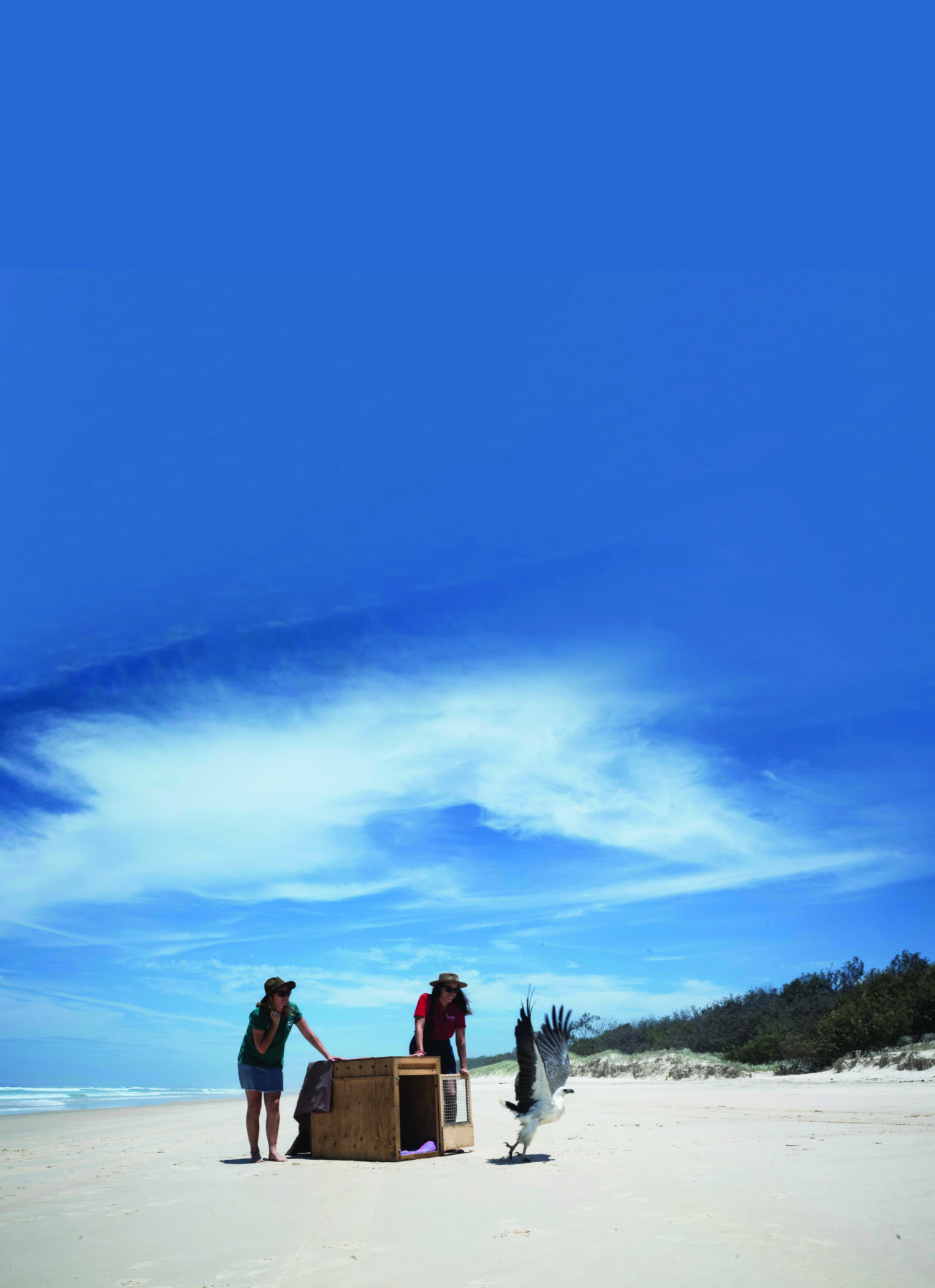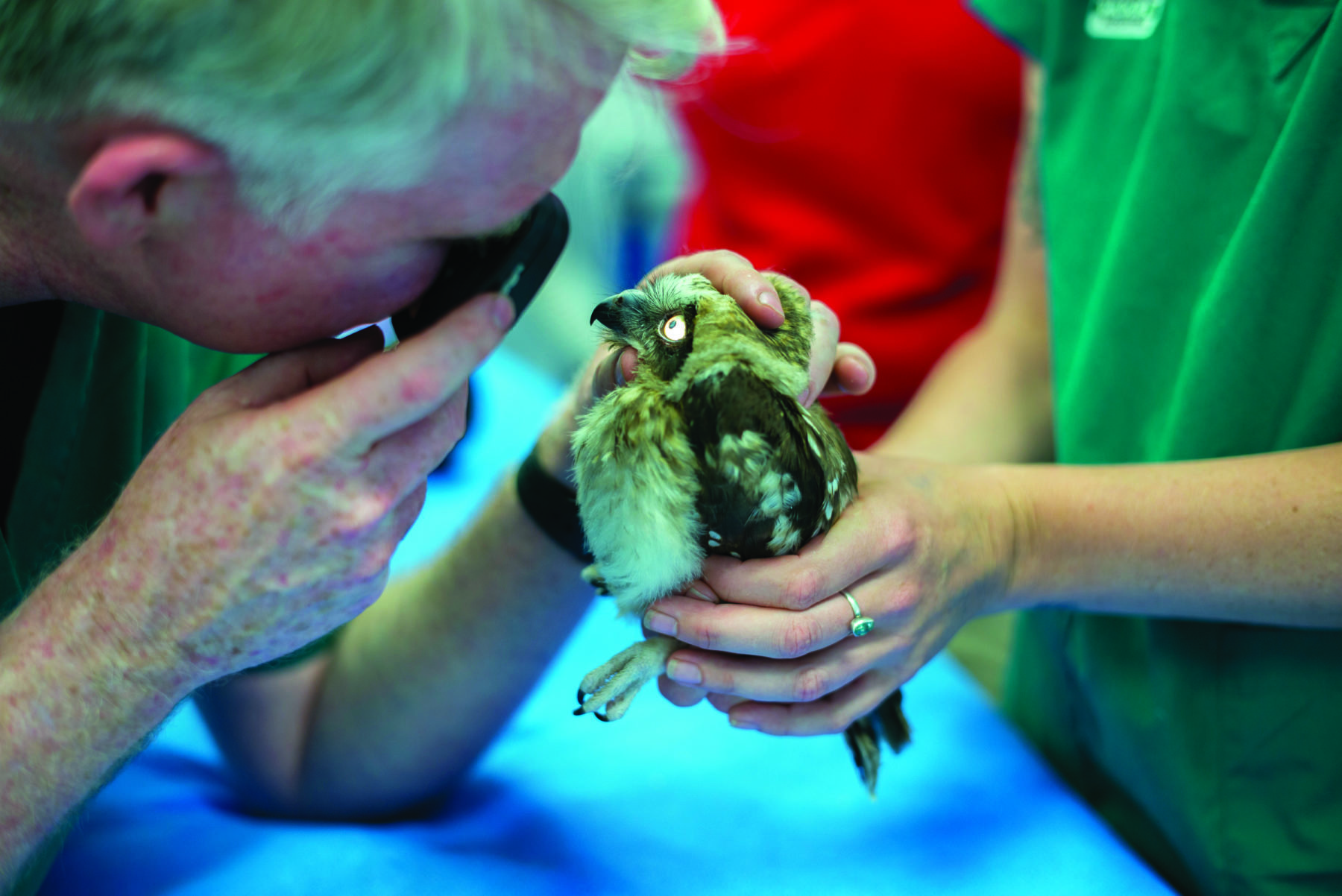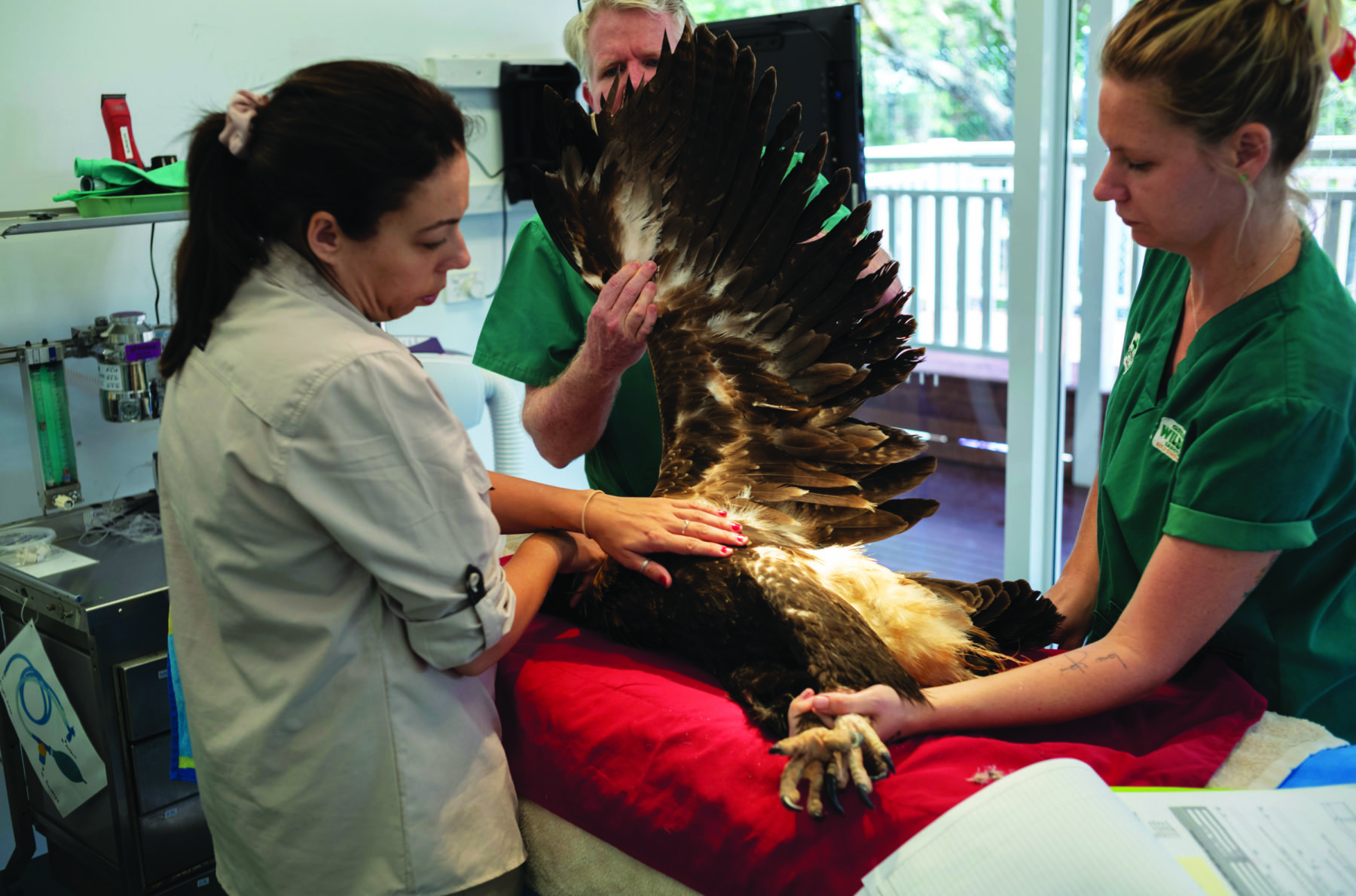The small wooden door slides slowly upwards. Snow pokes out her sleek head, takes two determined and graceful hops forward, then spreads her tawny wings, flashing a brilliant white chest, and with just a few powerful beats, is away. Free.
Snow, a white-bellied sea-eagle, is one of hundreds of coastal birds of prey that have recuperated as inpatients at the Currumbin Wildlife Hospital on Queensland’s Gold Coast. From outside, the hospital’s specialist Raptor Rehabilitation Facility looks like a huge shed. Inside are seven specially constructed ‘flights’, or enclosures. Humming away in one corner is a sturdy looking fridge with a sign saying “feather library”. It holds more than 300 feathers, removed from birds of prey that have succumbed to their injuries. These are used for imping, an ancient feather-mending treatment in which a new feather is used to replace a broken or missing one on a healthy bird.
The injured birds of prey – mostly raptors such as eagles and hawks, but also owls – recover slowly and the ultimate goal is to release them back into the wild. Whenever that momentous day arrives, each bird is carefully transported in a crate by expert volunteers, back to where it was originally found. Once freed from their crate, and without so much as a backward glance, they fly up to the nearest high perch to survey their newfound freedom. But questions have weighed heavily on the minds of those who get them to this point. Have the birds actually survived after being released? Were they able to adapt to the wild, or did they slowly starve to death? Now a new research project is finally getting answers.

Recovering raptors
As a girl, Vicky Thomson was fascinated by apex predators, particularly marine species. She went on to study them, and a trip to Borneo as a Griffith University undergraduate refined her focus.
“I started to love raptors because they are essentially sky sharks,” she says. Back home, Vicky began to study coastal raptors around the Gold Coast and realised they’d been largely ignored by scientists. She had some research ideas and the nearby Currumbin Wildlife Hospital had the subjects.
“I wanted to look at why they are coming in [injured] and what’s happened to them once they’re released,” she explains. “The hospital does all this work but doesn’t get to find out if the birds survive.”
Near the hospital’s operating theatres, veterinarian Dr Michael Pyne strides up to meet me, wearing pale green scrubs, a name tag and a big smile. For more than 20 years, he’s been the safe hands treating koalas, birds, snakes, and even a thorny devil from Birdsville brought in by a truckie, back to health at one of the world’s busiest wildlife hospitals.
Coastal raptors, he says, tend to be admitted for two reasons: either they are juveniles not coping, or they have fallen foul of humans. Many birds of prey are hit by cars, particularly nocturnal owls, which, like raptors, are hunters. Most eagles and other raptors are caught up in fishing lines or hooks.
The healing takes place at the Raptor Rehabilitation Facility. Its huge aviary is a shed as tall as it is wide, nestled in gum trees behind the hospital, and not far from where the daily bird show takes place at the Currumbin Wildlife Sanctuary. Inside, a hallway runs the length of the shed, and the only way to peer into the seven individual flights is through a hatch. The key to treating raptors, Michael says, is to be as hands off as possible.
“The tricky thing with treating them is the stress: they are quite stressy animals – that’s their nature – and that’s why this facility is very large,” he says. “It’s got netting so they don’t injure themselves if they fly into it and it’s very tall. They feel much more comfortable if they’re up high and out of the way of [ground-based] predators.”
Recuperating birds are caught only once a week, and all at once, so the facility can be cleaned top to bottom. “The rest of the week we have very minimal activity with them, because if they’re relaxed and stress-free, then they’ll eat well and chill out and then they’ll come good. If you’re stressing them all the time, you’ll have endless problems.”
There are strict rules for treating the raptors, including silence around the juveniles, to prevent them from becoming attached to – imprinting on – humans. “The young ones imprint very easily so there’s no talking in here and the food gets dropped down chutes,” Michael explains. “We don’t want them to associate food with people. These birds are smart. They soon learn that if they hear talking, then that’s where food comes from, and if you release a bird like that, when they hear someone talking they’ll go straight to them looking for food.”
Once the birds have healed and their fitness restored, it is time for them to be returned home. Peregrine falcons, in particular, need to be exercised with free flight so they are able to catch food. “We try to get the time and weather right,” Michael says. “We don’t want to spend months saving a life and then release them when it’s about to storm for four days in a row or release them at the end of the day when it’s about to get dark.” Most raptors are released late morning, when there is enough heat in the air, creating thermals for them to be able to fly upon to reach a safe perch and survey the area.
“Release day is a special time: it’s what we all live for,” Michael says. “You really see those birds come alive.” Occasionally, he will see repeat patients, evidence that at least some releases were successful. But until Michael and his colleagues began working with Vicky, they couldn’t identify any of the birds with certainty because wildlife regulations don’t permit banding unless it’s part of a research project. “It is frustrating because we’d like to have much better data,” Michael says.

The flight of Obsidian
On a dusty mine in the arid Queensland town of Condamine, a 400km drive north-west of the Gold Coast, a young white-bellied sea-eagle lay close to death, starving and dehydrated. After admission to Currumbin Wildlife Hospital, he was named Obsidian after volcanic glass, believed by some to possess healing properties.
Many weeks passed while the raptor gained strength and weight. Soon, he was ready again for the wild. On 18 March 2019 Obsidian was driven 100km west to Wyaralong Dam to avoid the drought that continued to bake the Condamine area. Next to the calm water of the reservoir, he spread his wings and leapt into the air – the hospital’s first raptor to be released with a GPS tracker.
“It was a really amazing experience,” Vicky recalls. “I’ll never forget watching him fly away and thinking, ‘Hang on, we can watch where you are now.’”
Obsidian was the first of three white-bellied sea-eagles that have been GPS-tracked so far. One of the others was Snow. It was a nervous first week, watching the birds’ progress online and hoping their signature dots didn’t disappear. Then, relief.
“The tracking showed they were successfully rehabilitated – they were hunting for themselves, were staying along the rivers and creeks and weren’t going to people,” Vicky says. “They ended up flying quite a ways – it was much wider than what was reported previously.”
In this case, “a ways” was an estimated 93,000ha home range. “Discovering that was exciting,” Vicky says. “We didn’t know how the rehab side of things would impact their movement.”

Rehabilitation of raptors
Regrettably, the tracing was cut short within seven months for both of the white-bellied sea-eagles.
“Obsidian was doing really well and flying so far, but he ended up getting caught in an illegally set drift net and he drowned,” Vicky says. “It was really unfortunate and really sad, but the positive was that his death had nothing to do with the rehab.” The whereabouts of Snow is still unknown.
“The device malfunctioned, I think,” Vicky says. “The battery kept failing but she was doing really well and flying quite far.”
A third GPS-tracked white-bellied sea-eagle, which had not only been hit by a car but had also swallowed a fishing hook, was released in February this year (pictured left) on Moreton Island. She is named Moreton and is yet to fly into mobile reception range. Vicky is hoping to fit more raptors with tracking devices.
“We can only track certain birds who have a certain weight and fitness and [that have] approval from the vets that they can carry a tracker and it isn’t going to cause injury,” Vicky explains. “We can’t track every raptor that comes through the door.”
What they can do for the others, however, as part of the research, is use leg bands. So far, 28 have been banded and re-released. “Only one banded whistling kite has been re-admitted, so that’s a good sign,” Vicky says.
“The Gold Coast is very urban and people do find the injured birds, so it’s good that only one band has returned.” There have also been reports from the Tweed area, in northern New South Wales, of a single metal leg band seen on an uninjured bird breeding with a nested female.
“It’s really encouraging so far,” Vicky says. “We had no idea how they would do and not many researchers globally have looked at the rehabilitation of raptors. There’s basically nothing, and all we know is that if they make it beyond six weeks in the wild, that’s considered a success.”
The tracking data of the two white-bellied sea-eagles showed the birds were able to hunt on their own and had learnt how to survive. It was particularly encouraging for the young male, Obsidian, because he had to learn the basics. “He didn’t have a lot of hunting experience,” Vicky says. “But the rehab didn’t hinder his ability to find food, so it shows that the rehab really does work and really is worth it.”
The tracking work will form part of Vicky’s PhD thesis. She is hoping to be able to follow one or two more sea-eagles before she submits it.
“These coastal raptors are so charismatic, but scientifically not much has been done,” she says. “On the Gold Coast, they are not considered under threat but their numbers are decreasing so it was important to study them where they’re not endangered yet. They’re doing seemingly well here, whereas in South Australia ospreys and sea-eagles are endangered.”
Ultimately, Vicky hopes her work will help the conservation of the birds she loves, because, she says, populations are declining globally. Urbanisation has already been linked to the decline of raptors in SA. So the Gold Coast having one of Australia’s highest urbanisation rates doesn’t augur well for local birds of prey populations.
Another part of Vicky’s PhD has been exploring the need to look after protected areas on the Gold Coast, Moreton and Bribie islands and in Brisbane, to perhaps mitigate the threat posed by growing urbanisation.
Coastal raptors are particularly sensitive during their breeding seasons. “They are getting hit by cars and caught up in fishing hooks and all those other urban threats so it’s important they have a safe space to breed,” Vicky explains.
Of all the dangers that come from living cheek to beak with humans, entanglement in fishing lines and hooks is the single biggest threat in south-eastern Queensland, Vicky has found.
“We can manage that through a change in human behaviour and by protecting large areas of nesting for birds,” she says. “There have been lots of positives to come out of my research but that is something that has stuck out and we need to do more work on it.” It’s not only Vicky who is pleased by the findings.
“We put a lot of work into these birds and we honestly didn’t know how well they did once we released them. You let them go and that is it,” Michael says. “But with Vicky’s work we managed to track two of these sea-eagles and it was wonderful to see they actually did do well, that they looked after themselves, and that they were fine. It was great to know that a lot of this work we were doing was really making a difference; it wasn’t just something we felt good about. These birds were going out there and were surviving.”






